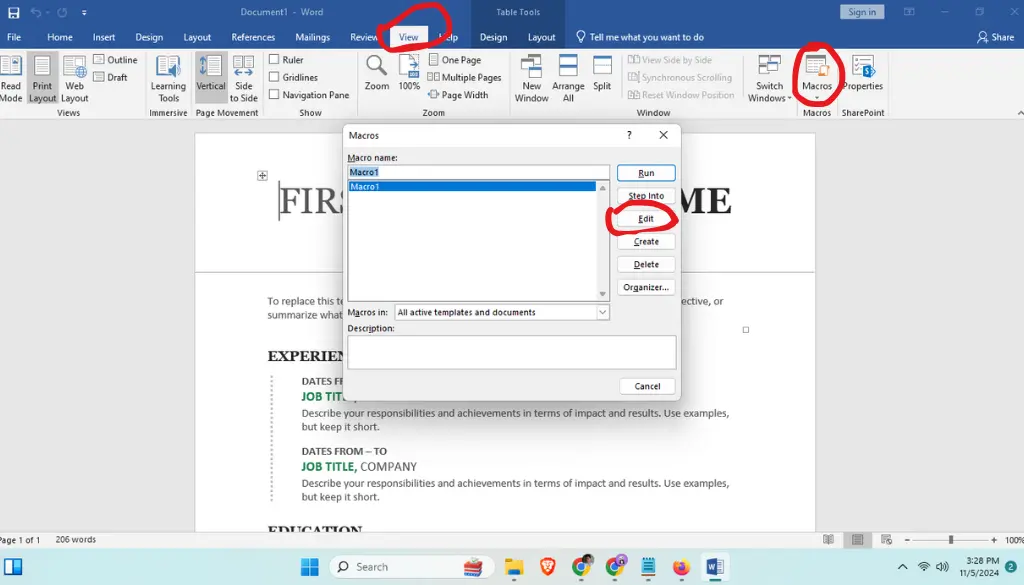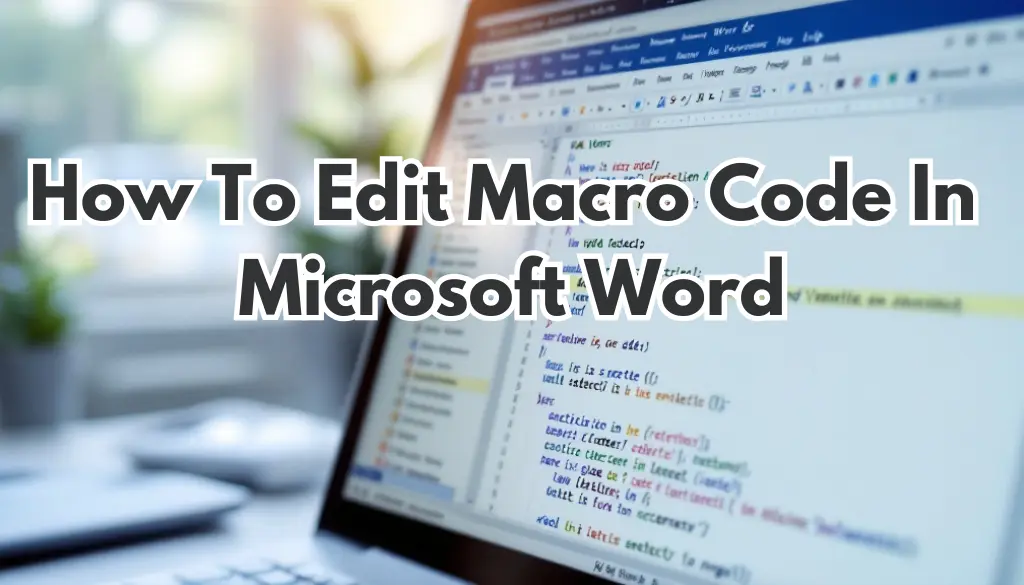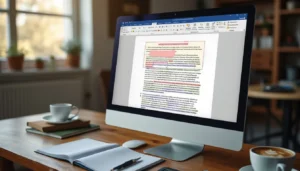Last Updated: August 8, 2025
Macros in Microsoft Word are a great way to automate repetitive tasks, save time, and avoid mistakes. But sometimes, the macro you recorded might need some changes to do exactly what you want. That’s when editing the macro code can help.
In this guide, we’ll show you how to edit macro code in MS Word step-by-step, so you can make your macros more useful and customized for your needs. For additional tips on enhancing your Word document, you might find how to change theme effects in MS Word helpful.
By the end of this guide, you’ll know how to change your macros to fit your workflow better. You’ll also learn how to add new features and make them more efficient. Let’s get started!
Table Of Contents
What Are Macros and Why Edit Them?
Macros are small programs that run inside MS Word to help you do tasks automatically. They are written in VBA (Visual Basic for Applications), which is a simple programming language used in Microsoft Office. Editing a macro means changing the VBA code to adjust its actions in Word to meet your specific needs.
Why Should You Edit Macros?
- Improve Efficiency: Sometimes the recorded macro has extra steps that aren’t needed. By editing the macro code, you can remove these extra actions and make it work better.
- Add Custom Actions: Editing lets you add new actions to the macro that weren’t included when you first recorded it.
- Fix Problems: If your macro doesn’t work the way you want, editing the code can help you fix it.
How to Edit Macro Code in MS Word
Editing macro code in MS Word might sound hard, but this step-by-step guide will make it easy.

Step 1: Open the Macro
- Open MS Word and click on the View tab.
- Click on Macros > View Macros.
- In the dialog box that appears, select the macro you want to edit and click Edit.
This will open the VBA Editor, where you can see and change the code for your macro.
Step 2: Understand the VBA Editor
The VBA Editor is where you can edit the macro. It might look a bit confusing at first but don’t worry, once you learn the basics, it’s easy to manage. Here are the key parts you need to know:
- Code Window: This is where you see and edit the code for your macro.
- Project Explorer: This shows all the macros and modules you have. You can use it to find and open different macros.
- Properties Window: Shows settings for the items selected in the Project Explorer.
Step 3: Edit the Macro Code
- In the Code Window, find the part of the code you want to change.
- You can add, change, or remove commands. For example, if you want your macro to make text bold, you would add this line:
Selection.Font.Bold = True- If you’re not familiar with VBA, start with small changes and test them to make sure everything works.
Step 4: Save and Test Your Macro
- After making changes, click the Save button in the VBA Editor or press Ctrl + S.
- Close the VBA Editor and go back to MS Word.
- Run your macro to see if it works the way you want.
Common Edits You Can Make to Macros
- Add Formatting: If you want your macro to change the style of the text, you can add lines to change the font size or color.
- Loop Through Actions: You can add a loop to repeat an action several times. For example:
For i = 1 To 5
Selection.TypeText Text:="Hello World"
Selection.TypeParagraph
Next iThis code will type “Hello World” five times.
- Add Conditional Statements: You can make your macro more flexible by adding conditions. For example, you can use an If statement to check something before taking an action:
If Selection.Text = "OpenAI" Then
Selection.Font.Italic = True
End IfThis will make the word “OpenAI” italic if it is selected.
Frequently Asked Questions (FAQs) About Editing Macro Code in MS Word
1. Can I Undo Changes Made in the VBA Editor?
No, there is no undo button in the VBA Editor. It’s a good idea to save a backup copy of your macro before making changes.
2. What If I Don’t Know How to Code in VBA?
You don’t need to be a programmer to edit VBA. Start by making small changes, like adding or removing simple commands. Over time, you’ll get more comfortable. There are also many online resources and tutorials to help you learn.
3. How Do I Debug a Macro?
The VBA Editor has tools that help you find and fix problems in your code. You can press F8 to go through the code one line at a time to see where it might be failing.
4. Can I Copy Code from One Macro to Another?
Yes, you can copy code from one macro and paste it into another. This is useful if you want to reuse parts of your macros.
Tips for Editing Macro Code in MS Word
1. Start Small
If you’re new to editing macros, make small changes first. Add a simple command, save, and test it. This will help you learn without feeling overwhelmed.
2. Use Comments
Adding comments to your code makes it easier to understand, especially if you come back to it later. You can add a comment by typing a single quote (') at the start of a line.
3. Test Frequently
Always test your macro after making changes. This helps you find mistakes quickly and makes it easier to fix them.
4. Back Up Your Macros
Before editing, copy the macro to a text file or make a duplicate. This way, you have a working version to go back to if something goes wrong.
Common Mistakes When Editing Macro Code
1. Forgetting to Save
Always save your macro before testing it. If you forget to save, your changes won’t be applied, which can be confusing.
2. Misplacing Commands
Be careful where you put new commands. The order of commands is important, and putting them in the wrong place can make your macro act strangely.
3. Not Testing Enough
Editing macros can be tricky, and even small mistakes can cause errors. Make sure to test thoroughly after each edit.
Conclusion
Editing macro code in MS Word is a great way to improve your workflow and make Word work better for you. For more information, you can visit Microsoft’s official guide on editing macros in Word. By following the steps in this guide, you can open, edit, and test your macros to make sure they do exactly what you need. Remember to start small, test often, and back up your work to avoid problems.
Ready to boost your productivity in MS Word? Start by editing one of your macros today and see how much more efficient your work can be. Even small changes can have a big impact on your workflow. If you have questions or need more tips, feel free to leave a comment below!





